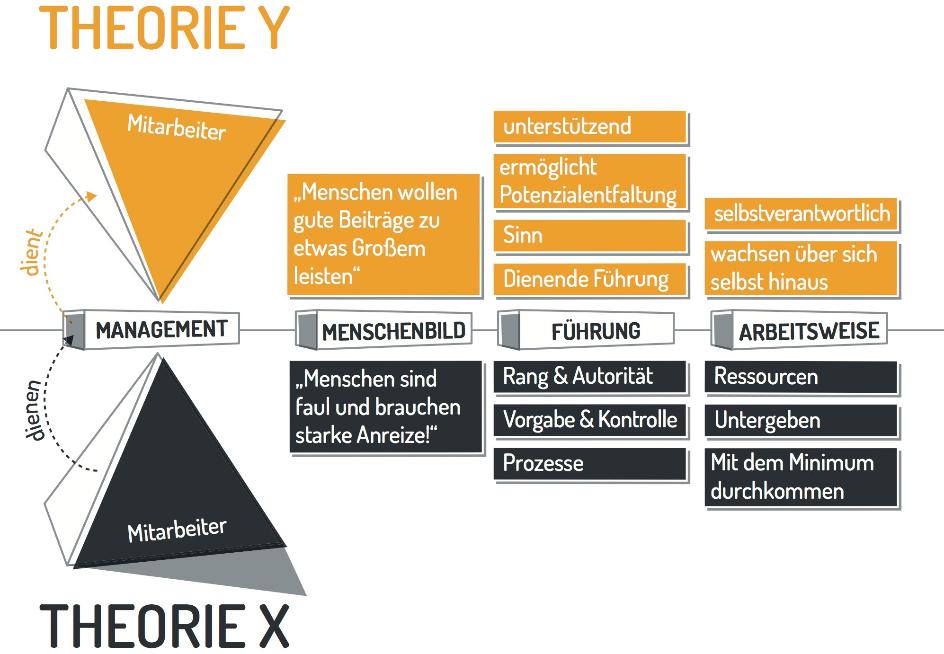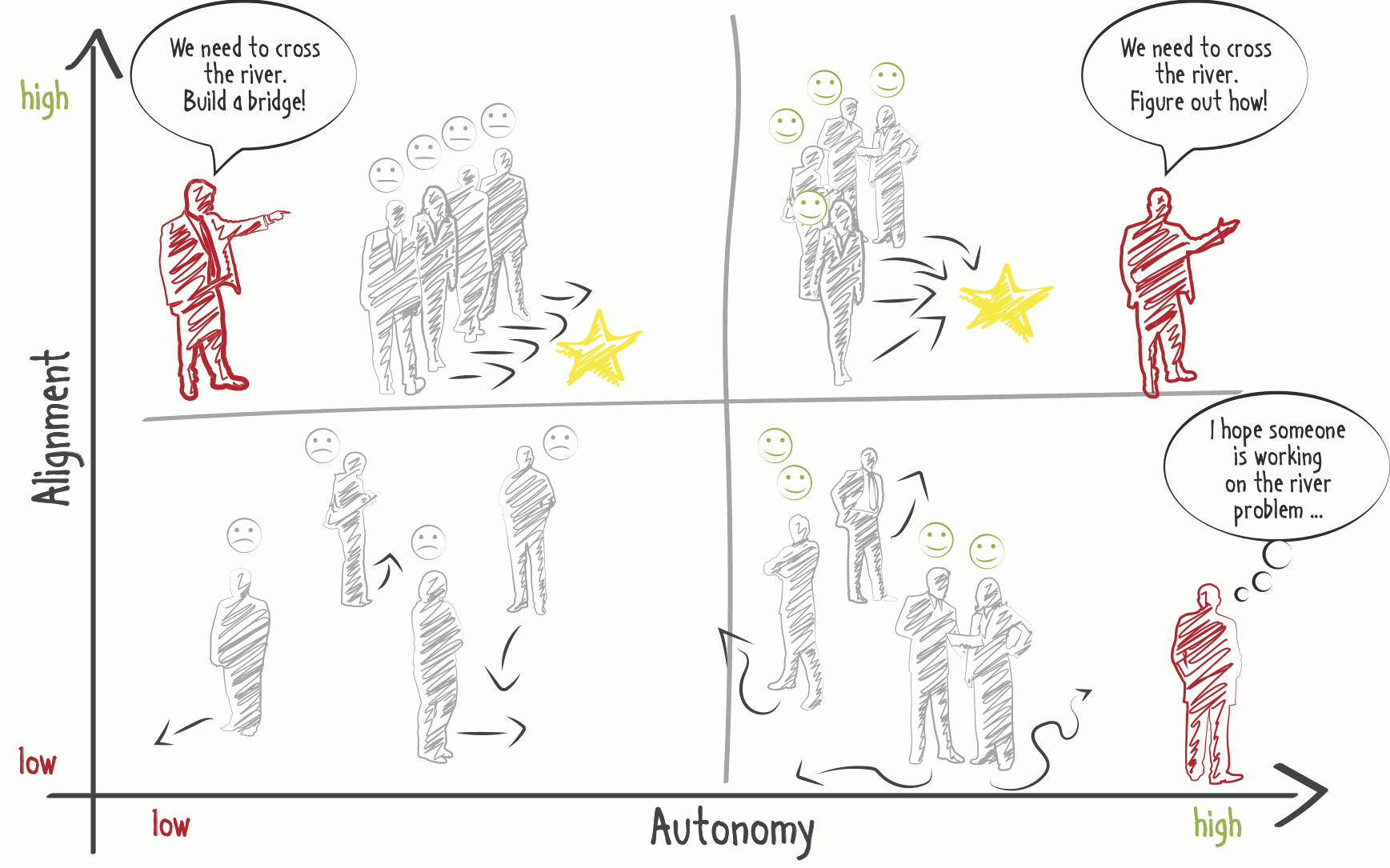Q&A
What is agile leadership?
Agile leadership or agile leadership encompasses the type of leadership or leaders needed in an agile environment. Agile impacts all employees and leaders and their behaviors. Agile leadership is focused on bringing about positive change in the organization and promoting agile principles and an agile mindset within the organization. For this, agile leaders need to be a role model for the agile mindset.
Why agile leadership? To keep pace with rapidly changing requirements!
Today's leaders are striving to keep pace with rapidly changing business needs and must recognize that rapid adaptation is critical to their success. They need to rethink their role as a leader, their relationship with their employees, and the culture of their company.
Leadership in Agile Lean environments requires a new understanding of leadership.
The leadership mindset that is at the bottom of agile leadership is well described in Douglas McGregor's X-Y theory. A good summary of this can be found in the book by Ulf Brandes: "Management Y: Agile, Scrum, Design Thinking & Co.: So gelingen der Wandel zur attraktiven und zukunftsfähigen Organisation", Campus, 2014, page 22ff. The following graphic was also taken from this book.

Agility needs an environment in which intrinsic motivation is encouraged.
The Theory Y belief system says that people are intrinsically ambitious and want to make their contribution to something. People are intrinsically motivated according to Theory Y. They can manage themselves and impose discipline and control on themselves to achieve meaningful goals. They see work as a source of satisfaction and take pleasure in their performance.
The opposite pole is an environment in which theory X is promoted - consciously or unconsciously. The belief here is that people are lazy by nature and try to avoid work as much as possible. According to theory X, people need to be extrinsically motivated. They need to be guided by guidelines and rewarded or sanctioned by appropriate measures. Many traditionally structured organizations have rules and instruments that are aligned to Theory X.
Agile leadership and agile leadership means that I create a framework that pays into Theory Y ideas.
Agility means designing an organization according to Y principles - and letting go of X techniques. This requires trust, courage and foresight. That's why agility is easy to understand, but challenging to implement.
Agile leadership means providing alignment and framework to enable autonomy.
Autonomy and common alignment are often perceived as opposites. In fact, autonomy needs alignment and a framework to be effective. The trick is to provide leadership in an agile organization that provides alignment and an organizational framework that enables autonomy to work towards a common goal. Chaos and anarchy, by the way, are the opposite of agility - albeit a willful misconception that is readily used.

Little alignment and little autonomy.
This is a micromanagement culture with a lot of ad hoc tasks. It is inefficient because different teams are constantly running in different and changing directions.
Little alignment and a lot of autonomy.
Here, each team does what it wants. A difficult task for managers who can only hope that the right thing happens
A lot of alignment, but little autonomy.
This is the top-down culture, where goals and path are set. This means a lot of work for managers.
A lot of alignment and a lot of autonomy.
This is the goal in a Lean-Agile organization: shared alignment via vision and goals while maintaining autonomy over the path.
An agile leader needs new tools for leadership
The "Y basic attitude" and the need of an agile organization for alignment and an enabling organizational framework needs suitable instruments for leadership. The four principles of lean management are a helpful guideline for leadership in an agile organization.

An agile leader should bring these principles to life in daily work. This also means that they should develop their own repertoire of techniques, which usually differ significantly from the leadership tools prevalent in organisations today.
The separation of powers promotes leadership
Gewaltenteilung ist das Prinzip, das die drei Führungsaspekte Ausrichtung, Rahmen und Autonomie trennt. Dadurch wird erreicht:
The principle of separation of powers divides the three leadership aspects of direction, framework and autonomy. This achieves:
-
a clearer focus
-
better decisions through mutual responsibility
-
accelerating decision-making and control by moving it closer to where the work is done.
Agile leadership should be formally introduced.
Classic organizations with a "directive master" always have the challenge that the organizational structures work with a bundling of responsibility to a single person. A separation of powers cannot then be mapped, and new leadership roles (such as the Scrum Master in Scrum) remain undocumented, neutered and unattractive. One of the most important steps in an agile transformation - and the accompanying introduction of agile leadership - is therefore to formally map a separation of powers in agile leadership together with the company's own HR department. This makes the roles of agile organizational structures transparent, seriously empowered and sustainably established. Only then will agile leadership become effective.
Contact us or make an appointment directly with one of us. We are Timo Foegen, Yvonne Fischer, Tina Eisoldt, Daniel Votta and Lutz Koch. We are looking forward to your call.
Agile Leadership - what is agile leadership?
As a leader in an agile environment, you face special challenges. How can you lead your organization when the teams are self-organized? Learn more about the agile leader here.
Certified Agile Leadership E-T-O (CAL ETO)
Step into the next era of agile leadership with our Certified Agile Leadership Training. Discover how coaching, mentoring and leading self-organized teams are key elements of agile leadership.
Certified Agile Leadership (Scrum Alliance)
The official training for agile leaders as an interactive workshop. With certificate from the Scrum Alliance.
Certified Agile Change Manager
Change to a more agile organization requires agile change. In this hands-on training, you will learn how this can be achieved.
Leadership of digital & agile organizations
How do I lead agile organizations? Why do these areas have a different DNA than the old part of the company?
Agile leadership
As an Agile Leader, an Agile Coach or an Agile Change Agent: we give you the tools to be effective in these roles.
Agile leadership - just get started
Intensive leadership research has been conducted in the literature for more than 80 years.
YOUR EXPERT FOR AGILE LEADERSHIP:
Frank Eberhard
wibas GmbH
Frank Eberhard
Otto-Hesse-Str. 19B
64293 Darmstadt
+49 6151 503349-0
